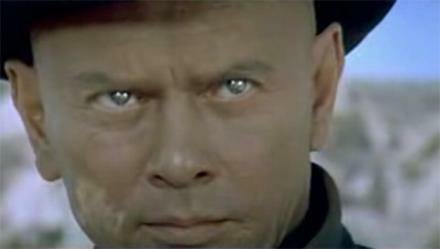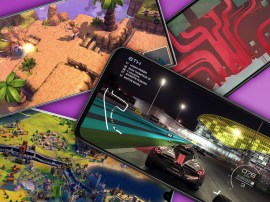15 CGI movie milestones
To celebrate Toy Story's 15th birthday, we've rounded up the 15 biggest CGI movie moments

Happy 15th birthday, Toy Story – the first full-length all-CGI movie. We’ve sifted through the history of computer animation to find the 15 films that used digital rendering to render us speechless…
Westworld (1973)
Gleaming-domed Yul Brynner as a homicidal robot cowboy in a future theme park gone wrong – surely one of the best premises ever. And Michael Crichton’s classic also featured the first use of CGI in the movies, with the digitised view of the world through Brynner’s mechanical eyes.
Superman (1978)
More was made of the extensive use of bluescreen (chroma key) tech to put together the flying sequences, but it was the CGI titles that made computer geeks weak at their spandex-clad knees. John Williams acknowledged it with a seminal accompanying score.
Tron (1982)
Who in the ’80s didn’t dream of whizzing through a digital landscape on a light cycle? And Tron: Legacy has just arrived to make neon piping cool again.
Young Sherlock Holmes (1985)
This schoolboy adventure of Holmes and Watson isn’t just surprisingly good Spielberg-fuelled fun; it was also the appearance of the first fully CGI character. The Stained Glass Knight took Industrial Light and Magic 4 months to create.
The Abyss (1989)
The biggest underwater set ever made was also the stage for the first 3D water effect – the pseudopod. Industrial Light and Magic were called in to render the claymation water alien as a shimmering tentacle of hydrous menace.
Terminator 2 (1991)
Robert Patrick gained the ability to walk through iron bars and rebuild himself from a pool of molten metal when he played Arnie’s rival, the stoney-faced T-1000. Ostensibly, that was because he was made from a mimetic alloy. In reality, it was the result of hours of image manipulation on a PC. Yes, PC.
Lawnmower Man (1992)
A bizarre scientific experiment turns a simple-minded gardener into a telekinetic genius with a penchant for virtual reality nookie. And who cooked up the on-screen VR for the film? Red Dead Redemption developer Rockstar San Diego. Fun fact: the sound editor, Frank Serafine, had also created some noises for Tron a decade earlier.
Jurassic Park (1993)
Steven Spielberg was no stranger to wacky effects, but the (quite literally) groundbreaking stomps of the computer-generated dinosaurs in Jurassic Park were a breakthrough in photorealistic creature creation and the willingly suspended disbelief of audiences saw it reel in record-breaking box office cash.
Toy Story (1995)
Woody, Buzz and crew first hit the silver screen 15 years ago in the first ever full-length CGI movie. Pixar set a high standard for itself to follow, but follow it did with Monsters, Inc., Finding Nemo, The Incredibles, WALL-E and Up, not to mention two Toy Story sequels, the latest in 3D.
Titanic (1997)
Who says Linux is useless? Titanic rendered much of its CG picture using the open-source OS and managed to recreate realistically flowing water, building on the work of 1995’s utterly underwhelming Waterworld in which Kevin Costner was out-acted by a post-apocalyptic puddle. Shame James Cameron can’t use computers to make his dialogue better.
The Matrix (1999)
For a film that spent so much time in slow-motion, The Matrix was a blur of computer animated tricks. Most notable was the use of bullet time interpolation to create the appearance of the camera orbiting the slow-moving action. There was also a bending spoon, but as everyone knows, there was no spoon – it was also the product of digital rendering.
Final Fantasy: The Spirits Within (2001)
Notable as the first attempt at a photo-realistic CGI movie, rather than as being any good. It actually wasn’t as bad as critics made out, but it certainly lacked much of the quirky charm of the game franchise, in favour of crash-bang visuals and a hot animated heroine. Did we just share too much?
Monsters, Inc. (2001)
If hair was a computer animator’s bad dream, fur was his nightmare. The Flintstones had gone before (in 1994) to tackle this prickly task, but it was the shimmering aquamarine strands of Sulley’s shagpile skin that showed you didn’t need Pedigree Chum for a lustrous coat.
The Lord of the Rings trilogy (2001-2003)
Weta Digital, the company behind Avatar’s digital acting, was also responsible for the CGI work in Peter Jackson’s conversion of the Tolkien epic. Most notable was Gollum – or Sméagol – a split-personality Stoor Hobbit who was able to virtually scramble across real rocks in a remarkably lifelike fashion.
Avatar (2009)
James Cameron’s blue people are – to date – the pinnacle of photorealism in CGI. To make life harder for everyone concerned, they’re also in 3D. But all that effort wasn’t wasted – it rocked box offices and scooped a load of Oscars despite a thoroughly two-dimensional plot.
Related stories
– 13 scariest horror movies ever
– 10 of the best gadget movies



